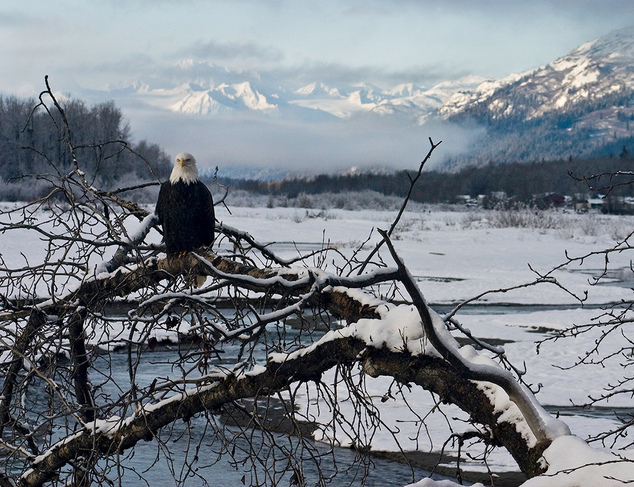Critics question mine exploration near Alaska eagle preserve
ANCHORAGE, Alaska (AP) — In early winter, after most tourists have fled Alaska, another kind of visitor flies in: bald eagles, up to 4,000 of them.
In the world's largest congregation of bald eagles, they gather along the Chilkat River in southeast Alaska to feast on salmon carcasses washed downstream after spawning. Well after other rivers have frozen, the river remains open.
Wildlife advocates are concerned that a possible mining project near a major tributary of the river could threaten the eagles.

In this undated photo provided the American Bald Eagle Foundation, a bald eagle perches on a tree branch along the Chilkat River within the Alaska Chilkat Bald Eagle Preserve outside Haines, Alaska. The preserve is about 10 miles downstream from a copper and zinc prospect that could someday be developed into a hard rock mine. Critics say a spill from mining operations could harm salmon in the rivers of the preserve, where up to 4,000 eagles gather each winter to feed on the fish after they spawn. (Cheryl McRoberts/American Bald Eagle Foundation via AP)
A Canadian company, backed by a Japanese metals firm, is spending millions to explore a copper and zinc deposit that might someday turn into a hard rock mine about 10 miles upriver of the preserve.
"That just seems like a very foolish thing to do, to risk everything we have for a few years of economic development," said environmental activist Gershon Cohen, who lives in nearby Haines.
Mine advocates say mining and wildlife can co-exist, noting that the state's strict mining regulations will require measures protecting salmon and eagles.
But long before the specifics of a mine are designed, wildlife advocates question why a development with the potential for a deadly spill would ever be considered on a site close to salmon habitat that nourishes the eagles.
Haines is a commercial fishing and tourism town of 2,500 with an asset missing in most other southeast Alaska towns: a highway that climbs through nearby mountains to connect to the continental road system.
The highway and port are a huge draw for Vancouver, British Columbia-based Constantine Metal Resources Ltd., a company formed in 2006 to explore for copper, zinc, gold and silver in the project on five acres about 35 miles northwest of the city.
"We have a promising project that's growing, that we've been investing in for a long time, but it requires more work," said Darwin Green, vice president of exploration, in a phone interview.
Japan's Dowa Metals & Mining Co. in 2013 agreed to invest $22 million in what's being called the Palmer Project over four years in exchange for a 49 percent interest. The Bureau of Land Management is reviewing Constantine's application to build roads and expand exploration to 40 acres.
But a decision on production is years off, Green said.
"The question everyone wants to know — 'When will it be a mine — is one I can't answer," he said.
The project ultimately could take the form of a medium-size underground mine, with high grade ore extracted and trucked to port, loaded on ships and moved to overseas smelters. Baseline information collected during exploration would shape mine design.
But it's much too early, he said, to provide meaningful details about what processing would entail. "What we do know is that Alaska has incredibly stringent regulations and laws that are very protective of the environment we operate in," Green said.
Cohen, a sponsor of the 2006 cruise ship ballot initiative that required the vessels to get state pollution discharge permits for wastewater, is frustrated by a system in which debate about a mine that could damage a world-class natural attraction does not begin until after millions of dollars have been spent.
"If you wait until it's later in the process, then they turn that around and say, 'Where were you years ago when we first started this?'" he said.
No matter what Constantine promises, he said, it ultimately is an exploration company.
"Once they find a major mining company that wants to buy the prospect, they will have little to nothing to say about how the mine actually gets developed," he said. "It will be the major mining partner who will bring in their engineers and they will decide how the mine needs to be developed."
The specifics of a future mine are not needed to know that it will produce millions of gallons of wastewater contaminated with heavy metals in a location prone to earthquakes and heavy rainfall, Cohen said.
"There is a long history of dams for tailings ponds failing under these conditions," he said.

In this undated photo provided the American Bald Eagle Foundation, a bald eagle feeds on a salmon carcass in the Alaska Chilkat Bald Eagle Preserve outside Haines, Alaska. The preserve is about 10 miles downstream from a copper and zinc prospect that could someday be developed into a hard rock mine. Critics say a spill from mining operations could harm salmon in the rivers of the preserve, where up to 4,000 eagles gather each winter to feed on the fish after they spawn. (Cheryl McRoberts/American Bald Eagle Foundation via AP)























































































































































































